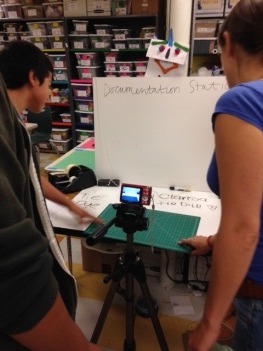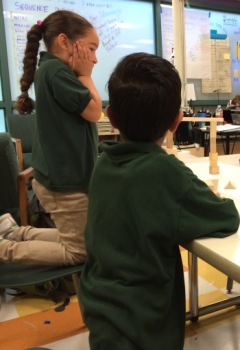This is the fifth in a series of blog posts about Maker Ed’s Open Portfolio Project work during the summer and fall 2014. These posts are also written in conjunction with the Research Briefs being released throughout the fall and winter of 2014.
An innovative K-12 public charter school located close to the airport in Oakland, CA, Lighthouse Community Charter School serves a largely Hispanic and low-income student population. At school, seniors stroll alongside pint-size kindergarteners, and in the past few years, one particular theme has been emerging in all K-12 curriculum, classes, and approaches: making.
Lighthouse is one of the 10 field sites that the Open Portfolio Project team visited to learn more about current work and perspectives around maker portfolio creation and documentation. Many years ago, making began at Lighthouse as part of the a high school Robotics elective, taught by science teacher Aaron Vanderwerff; while his students built and programmed robots for the BotBall tournament, they also created independent projects to share at the Maker Faire. As the class evolved, Aaron began to develop a year-long plan: simple, skill-building projects (that still allowed for personalization) in the first few months, and during the second semester, self-directed projects born entirely of student interest, to be shown at Maker Faire Bay Area every May.
Since Fall 2013, making has developed into a school-wide effort, integrated into classrooms and subjects across K-12 and centered at the interdisciplinary makerspace, named the Creativity Lab. It’s a colorful room of standard classroom size with walls lined with floor-to-ceiling shelves, all filled with well-organized plastic see-through bins of materials, from modeling clay, pom poms, nets, tinker toys, fabric markets and paint, and googly eyes to resistors, DC motors, hole punches, tape, crayons, post-its and puzzle pieces. Two sinks, some floor equipment (a large-format printer and vinyl cutter), a small “office” area with desks and chairs, and additional shelving that contains primarily visual, tangible examples of student projects and works-in-progress, more supplies, and a growing library of educational and making books fill out the perimeter of the room. In the middle are 6 student tables with about 4-6 chairs each where students gather to make, create, and design.
The Creativity Lab program now hosts four part-time educators, teaching Making electives (7-12th grades) and in the ASP (after-school program), and two Maker Ed AmeriCorps VISTA volunteers, who focus their efforts on behind-the-scenes coordination and implementation of making experiences within and outside of Lighthouse. They work with teachers to develop projects and integrate making into curriculum of core classes (Science, Math, Humanities, Home Language, etc), as well as create professional development opportunities for teachers in the greater community (Oakland Unified and beyond). In K-4 classrooms, the Creativity Lab staff also work with teachers to create mini-makerspaces within their respective rooms. And the high school science and robotics classroom serves as another makerspace, hosting more of the woodworking and heavy-duty tools and equipment.
 Aaron and teachers have been actively thinking and experimenting with documentation over the past 3-4 years, whether developing project guides for others to use or promoting student documentation in preparation for Maker Faire. In the summer of 2014, the team experimented with a simple documentation station that took center stage in the Creativity Lab, in order to capture what summer students were creating. Students headed to Maker Faire create posters to highlight their work and processes, and art teachers take time to allow K-6 students to curate their portfolio of work. The high school making electives kept a tumblr blog, where posts were often prompted by simple direction: Take a picture of your project in its current state, and write about what you did in the past week.” The tagline of the blog? “Lots of people making lots of stuff.”
Aaron and teachers have been actively thinking and experimenting with documentation over the past 3-4 years, whether developing project guides for others to use or promoting student documentation in preparation for Maker Faire. In the summer of 2014, the team experimented with a simple documentation station that took center stage in the Creativity Lab, in order to capture what summer students were creating. Students headed to Maker Faire create posters to highlight their work and processes, and art teachers take time to allow K-6 students to curate their portfolio of work. The high school making electives kept a tumblr blog, where posts were often prompted by simple direction: Take a picture of your project in its current state, and write about what you did in the past week.” The tagline of the blog? “Lots of people making lots of stuff.”
As Lighthouse continues to integrate making into its students’ everyday learning, it’s obvious that making takes many different forms and styles. As such, documentation and portfolios do, too. One particular student–who might be found hiding from math class to make stuff instead–is in the midst of creating a laser harp, a project she started last academic year. When describing her ongoing harp project, she says that instead of using regular strings, “I use lasers.” They’re implanted through the bottom of the harp, and photodetectors are added at the top; when a player crosses his or her hands through the lasers, it disrupts the lasers and the harp plays a sound. She doesn’t write much in the class blog, but she actively uses her notebook, sketching in it and organizing it in a way that helps her easily locate the info she needs (like measurements). Why doesn’t she blog? She answers, “It’s not about not liking technology or blogs; I like to have it on-hand.” This example helps us better understand the inclinations and tendencies of students in their documentation practices, maybe even preferences for tangible objects, as well as the challenges facing the creation of digital portfolios. In this instance, we see how portfolios can serve different purposes; some are created for oneself (e.g., organizing, sketching), and some are created for others (e.g., showcasing, sharing).
At Lighthouse, this documentation is leveraged when students advance from one grade grouping to the next (every 2 grade levels). At these stages, students undergo a review of their work in a “Passage Presentation” with teachers and parents, showcasing a portfolio of “big projects” that are kept in a binder and passed between teachers. In thinking about making, this set of Passage milestones may be the perfect opportunity for capturing even more student work.
Lighthouse is in a prime spot to design and develop ways for students to capture and reflect on their work, across a variety of subjects and grade levels, and we’re excited to continue to watch and encourage what they do!




Leave a Reply